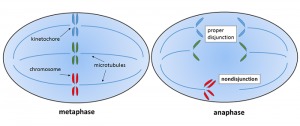Nondisjunction Definition
Nondisjunction occurs in cell division when chromosomes do not divide properly. Chromosomes contain all of a cell’s DNA, which it needs in order to function and reproduce. Normally, when a cell divides, the chromosomes line up in an orderly way and then separate from each other before cell division. When these chromosomes fail to separate properly, nondisjunction has occurred. The resulting daughter cells have an incorrect number of chromosomes; one may have too many, while another may have too few. This causes problems in cell function because a cell cannot function normally without the right amount of chromosomes.
Types of Nondisjunction
Nondisjunction can occur during mitosis, meiosis I, or meiosis II.
During Mitosis
Somatic cells, or cells of the body, divide through mitosis. From each original parent cell, two identical daughter cells are created. In the parent cell, each chromosome is composed of two identical sister chromatids. During the anaphase stage, these chromatids normally separate, and one chromatid goes into each daughter cell. However, when nondisjunction occurs, the chromatids do not separate. The result is that one cell receives both chromatids, while the other cell receives neither. Each daughter cell then has an abnormal number of chromosomes when mitosis is complete; one cell has an extra chromosome, while the other is missing one.
The diagram below shows nondisjunction taking place in mitosis:
During Meiosis I
Gametes (eggs and sperm) are made through meiosis. One cell divides into four daughter cells through the combined processes of meiosis I and meiosis II. Meiosis I is similar to mitosis, but in meiosis I each pair of chromosomes lines up next to each other in preparation for making gametes, whereas in mitosis, the chromosomes are all in one line. In anaphase of meiosis I, nondisjunction happens when a pair of homologous chromosomes does not separate. In the resulting cells, one cell has two copies of a chromosome, while the other cell has no copies. When each of these cells goes on to divide into two cells during meiosis II, the four total cells produced will all have chromosomal abnormalities.
During Meiosis II
Even if a cell divides normally in meiosis I, nondisjunction can still occur in meiosis II. During meiosis II, each cell splits and goes from diploid (two pairs of each chromosome) to haploid (one of each chromosome) in preparation for fertilization. If a pair of sister chromatids fail to separate properly during anaphase of meiosis II, one daughter cell will have an extra chromosome and one daughter cell will be missing a chromosome. If the other daughter cell created in meiosis I splits properly, the other two of the four total daughter cells created during meiosis II will have the normal number of chromosomes.
Examples of Nondisjunction Disorders
Examples #1: Down Syndrome
Down syndrome occurs as a result of nondisjunction during meiosis I that produces an egg cell with an extra copy of chromosome 21. The fertilized egg has three copies of chromosome 21—two from the mother, and one from the father—which is called a trisomy. People with Down syndrome have three copies of chromosome 21 in all of their somatic cells.
The extra chromosome in the cells of those with Down syndrome is responsible for a host of characteristics, including delays in physical growth, certain facial features, and mild intellectual disability. Rates of nondisjunction increase with age, which is why older mothers have a higher chance of giving birth to a child with Down syndrome. According to Mayo Clinic, this chance drastically increases between the ages of 35 and 45, going from 1 in 350 at 35 years to 1 in 30 at 45 years.
Examples #2: Sex Chromosome Aneuploidy
Sex chromosome aneuploidy is the term for an abnormal number of sex chromosomes. Normally, females have two X chromosomes, while males have one X and one Y. Nondisjunction can cause individuals to be born female with one X (Turner syndrome), female with three X chromosomes (Trisomy X), male with XXY (Klinefelter syndrome), or male with XYY (XYY syndrome). Rarer combinations, such as having five X chromosomes, can also occur. Sometimes, sex chromosome aneuploidy goes unnoticed in individuals, but other times it may present as a recognizable syndrome with characteristics such as intellectual disability.
Examples #3: Other Types of Trisomy
Most cases of trisomy result in miscarriage during the first trimester of pregnancy because the fetus cannot survive the chromosomal abnormality. Trisomy 16 occurs in over 1% of pregnancies and is the most common trisomy, but most individuals with this trisomy do not survive unless some of their cells are normal.
The three most common types of trisomy that are survivable are Trisomy 21 (Down syndrome), Trisomy 18 (Edwards syndrome), and Trisomy 13 (Patau syndrome).
Related Biology Terms
- Mitosis – the process by which somatic cells divide into two identical daughter cells.
- Meiosis – the process by which four gamete (sex) cells are produced from one parent cell; it consists of meiosis I and meiosis II.
- Anaphase – the stage of mitosis and meiosis where chromosomes separate from one another before cell division.
- Trisomy – a cell has three copies of a chromosome instead of two.
Test Your Knowledge of Nondisjunction
1. Nondisjunction can occur in what type of cell division?
A. Mitosis
B. Meiosis I
C. Meiosis II
D. All of the above
2. In what phase in the process of cell division can nondisjunction occur?
A. Prophase
B. Metaphase
C. Anaphase
D. Telophase
3. Which trisomy is associated with Down syndrome?
A. Trisomy 18
B. Trisomy 21
C. Trisomy 13
D. Trisomy 16
Nondisjunction

No comments:
Post a Comment